
Giza Pyramid Party





You can look at the many vendors of food, trinkets and transportation as a curse or a a relief. It is true that they are relentless in their offers to provide transportation, food or souvenirs. However, spend a little time in this little corner of the Sahara desert with it's extremes of heat and distance, and you may want to reconsider your opinion. You spent a fair amount of money getting to the pyramids, why not hire a driver or a camel to make the most of your visit, rather than slogging it out on foot. Not to mention that the pyramids are really gigantic and look different from almost every position. This is not to say that there is no risk of paying more than the going rate, however even if you are overcharged, it really is not that important in the grand scheme of your trip and Egyptian currency is relatively inexpensive. Despite efforts by the Egyptian authorities to increase security, thieves and pickpockets still exist, it pays to be aware of your surroundings. Official prices for horse carriages are about 100 Egyptian pounds (about $12) per hour, camels and horses are about the same but you need to pay for the guide's horse as well. You should be able to haggle as well.
Giza Plateau



The suburb of Cairo, Giza, is rapidly encroaching on the Giza plateau, where the pyramids were first built on the West Bank of the Nile, far away in the Saharan desert, on an elevated plateau. Time has changed everything concerning the locale of the pyramids. Between 1882 and 1937, the population of Cairo more than tripled, from 347,000 to 1.3 million and its area increased from 10 to 163 square kilometres (4 to 63 square miles). Although the Cairo metropolis extends away from the Nile in all directions, the city of Cairo resides only on the east bank of the river and two islands within it, for a total area of 453 square kilometres (175 square miles). Cairo's population has doubled since the 1960s, reaching close to seven million (with an additional ten million in its urban area). The western bank of the Nile is commonly included within the urban area of Cairo, but it composes the city of Giza and the Giza Governorate. Giza has also undergone significant expansion over recent years, and today the city, although still a suburb of Cairo, has a population of 2.7 million. You can even take the metro from downtown Cairo to Giza. Take the red line metro to the Giza Station stop for 1 LE each way (.20 cents) and then from Giza Station you can catch a cab to the Pyramids for 20 LE ($4).
Giza Necropolis


Giza can be subdivided into two groupings of monuments, clearly defined and separated by a wadi or valley. The larger grouping consists of the three “Great” pyramids of Khufu, Khephren (Khafre), and Menkaure, the Sphinx, attendant temples and outbuildings, and the private mastabas of the nobility. Though the three Great Pyramids are the most famous and prominent monuments at Giza, the site has actually been a Necropolis almost since the beginning of Pharaonic Egypt. A tomb just on the outskirts of the Giza site dates from the reign of the First Dynasty Pharaoh Wadj (Djet), and jar sealings discovered in a tomb in the southern part of Giza mention the Second Dynasty Pharaoh Ninetjer. But it was the Fourth Dynasty Pharaoh Khufu (Cheops) who placed Giza forever at the heart of funerary devotion, a city of the dead that dwarfed the cities of the living nearby. In order to build his complex, he had to clear away many of the old tombs, filling in their shafts or even totally destroying them. His pyramid, the largest of all the pyramids in Egypt (though it should be noted that it surpasses the Red Pyramid at Dahshur built by his father Snefru by only ten meters), dominates the sandy plain.
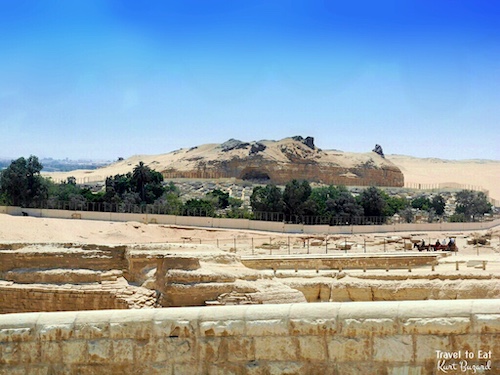
The second grouping, located on the ridge to the southeast, contains a number of private tombs of citizens of various classes. While the majority of the monuments of the larger grouping are made from limestone that was quarried and transported to the site, the tombs of the smaller grouping are simply carved out of the native living rock.
Great Pyramid of Khufu (Cheops)




The Great Pyramid of Giza (also known as the Pyramid of Khufu or the Pyramid of Cheops) is the oldest and largest of the three pyramids in the Giza pyramid complex bordering what is now El Giza, Egypt. Based on a mark in an interior chamber naming the work gang and a reference to fourth dynasty Egyptian Pharaoh Khufu, Egyptologists believe that the pyramid was built as a tomb over a 10 to 20-year period concluding around 2560 BC. Initially at 146.5 meters (481 feet), the Great Pyramid was the tallest man-made structure in the world for more than 3,800 years. The Great Pyramid of Khufu (Cheops) covers thirteen acres. It is a solid mass of masonry containing 2,300,000 blocks of limestone, each weighing on an average two and a half tons, that is each block is as heavy as an average car. The sides of the pyramid at the base are 755 feet long, that is about a block and three quarters (counting twelve city blocks to a mile), and the building was nearly 500 feet high. An ancient story tells us that a hundred thousand men were working on this royal tomb for twenty years, and we can well believe it. The pyramids on the Giza plateau are 146.59 meters (Khufu / Cheops) and 143.87 meters (Khafre / Chefren) respectively the largest, however there are over 30 major pyramids and a myriad of smaller pyramids in Egypt.
Interesting Observations
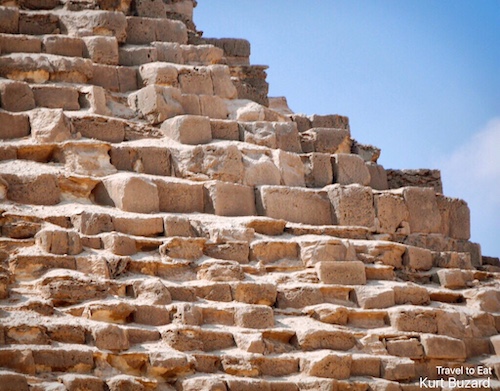
Even though the individual stones of the Great Pyramid are enormous at ground level, as you move up the pyramid there are considerable variations in size of the individual blocks. This might be explained by the increasing difficulty of moving the stones as the height increased.
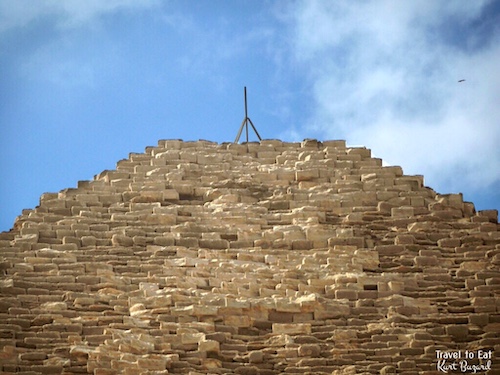
Another interesting anomaly is at the top of the Great Pyramid. It appears that the Great Pyramid was never finished since the top is flat, and not pointed, as it should be. It has a truncated summit which is coarse and uneven and measures about 30 square feet. Most pyramids were crowned with a top-stone, capstone or pyramidion that completed their structure. This pyramid does not currently have one and it appears that it never did. One of the earliest references to the missing top-stone (or capstone) is from Diodorus Siculus (60 BC). He tells us that in his day, when the Pyramid stood with its casing stones intact, the structure was “complete and without the least decay, and yet it lacked its apex stone”. Since the top-stone could not have been dismantled without first demolishing the smooth casing-stones, so that the core masonry formed steps of approach to it, this statement of Diodorus supports the theory that the top-stone had never been added to the structure. Or maybe it just fell off and got lost.
Entrance to the Great Pyramid


Today tourists enter the Great Pyramid via the Robbers' Tunnel, a tunnel created around 820 CE by Caliph al Ma'mun's workmen using a battering ram. The tunnel is cut straight through the masonry of the pyramid for approximately 27 metres (89 ft), then turns sharply left to encounter the blocking stones in the Ascending Passage. It is believed that their efforts dislodged the stone fitted in the ceiling of the Descending Passage to hide the entrance to the Ascending Passage and it was the noise of that stone falling and then sliding down the “Descending Passage”, which alerted them to the need to turn left. Unable to remove these stones, however, the workmen tunnelled up beside them through the softer limestone of the Pyramid until they reached the “Ascending Passage”.
Surrounding Structures




There are a variety of cemeteries and buildings surrounding the Great Pyramid. Obviously such an imposing and grand structure attracted many people who wished to be buried in it's proximity. Egyptologists believe that the Great Pyramid was built by tens of thousands of skilled workers who camped near the pyramids and worked for a salary or as a form of paying taxes until the construction was completed.The worker's cemeteries were discovered in 1990 by archaeologists Zahi Hawass and Mark Lehner. The Great Pyramid of Giza is the main part of a complex setting of buildings that included two mortuary temples in honor of Khufu (one close to the pyramid and one near the Nile), three smaller pyramids for Khufu's wives, an even smaller “satellite” pyramid, a raised causeway connecting the two temples, and small mastaba tombs surrounding the pyramid for nobles. One of the small pyramids contains the tomb of queen Hetepheres (discovered in 1925), sister and wife of Sneferu and the mother of Khufu. There was a town for the workers of Giza, which included a cemetery, bakeries, a beer factory and a copper smelting complex.
The Pharaoh, Scribes and Taxation
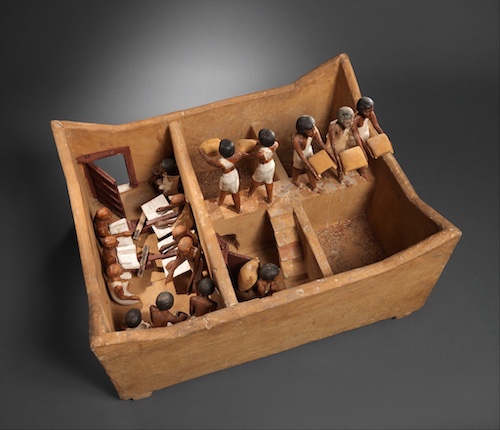
It must have required a very skillful ruler and a great body of officials to manage and to feed a hundred thousand workmen around this building. The king who controlled such vast undertakings was no longer a local chieftain, but he now ruled a united Egypt, the earliest great unified nation, comprising millions of people. The king was so respected that the people did not mention him by name, but instead they spoke of the palace in which he lived, that is the “Great House” or in Egyptian, “Pharaoh”. He had his local officials and priests collecting taxes all over Egypt. The king's huge central offices, occupying low, sun-baked-brick buildings, sheltered an army of clerks with their reed pens and their rolls of papyrus, keeping the king's records and accounts. The taxes received from the people here were not in money, coined money did not yet exist. Payments were made in produce, grain, live stock, wine, honey, linen and labor. With the exception of the cattle, these had to be stored in granaries and storehouses, a vast group of which formed the treasury of the king. A barter economy such as this required extensive and accurate records, proving that writing was well developed by the beginning of the Old Kingdom (2691-2625 to 2200-2150 BCE).
Pyramid of Khafre (Chefren)




The Pyramid of Khafre is the second-tallest and second-largest of the Ancient Egyptian Pyramids of Giza and the tomb of the Fourth-Dynasty pharaoh Khafre (Chefren), who ruled from 2558 to 2532 BC. Like the Great Pyramid, a rock outcropping was used in the core. Due to the slope of the plateau, the northwest corner was cut 10 m (33 ft) out of the rock subsoil and the southeast corner is built up. Though Khafre's pyramid is shorter than his father Khufu's nearby Great Pyramid, Khafre made up for it by building at a higher elevation and surrounding his pyramid with a more elaborate complex. Khafre's necropolis also boasted an unprecedented profusion of statues, among them the Sphinx. Carved from bedrock in front of Khafre's pyramid, the Sphinx depicts the pharaoh as a human-headed lion, wearing the headdress of the pharaohs. The great statue is the embodiment of Khafre, the third ruler of the 4th dynasty, as the god Horus. In 1853, Auguste Mariette partially excavated Khafre's valley temple, and, in 1858, while completing its clearance, he managed to discover a diorite statue of Khafre.
Casing Stones
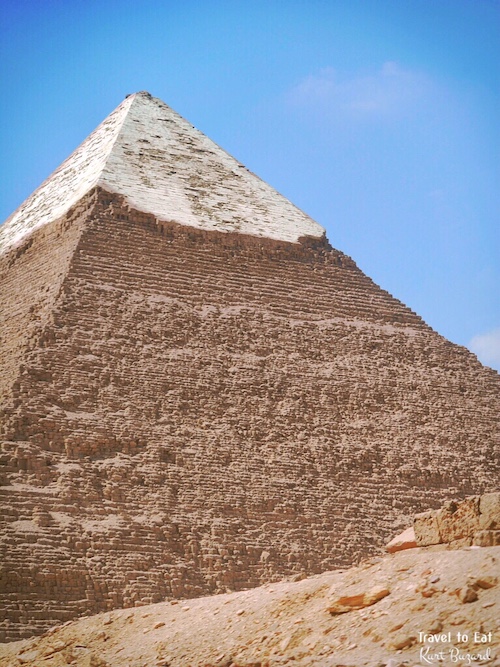
At completion, all of the Giza pyramids were surfaced by white “casing stones”, slant-faced, but flat-topped, blocks of highly polished white limestone. These were carefully cut to what is approximately a face slope with a “seked” of 5½ palms to give the required dimensions. Visibly, all that remains is the underlying stepped core structure seen today. In AD 1303, a massive earthquake loosened many of the outer casing stones, which were then carted away by Bahri Sultan An-Nasir Nasir-ad-Din al-Hasan in 1356 to build mosques and fortresses in nearby Cairo. Many more casing stones were removed from the great pyramids by Muhammad Ali Pasha in the early 19th century to build the upper portion of his Alabaster Mosque in Cairo not far from Giza. These limestone casings can still be seen as parts of these structures. Later explorers reported massive piles of rubble at the base of the pyramids left over from the continuing collapse of the casing stones, which were subsequently cleared away during continuing excavations of the site. Thermal expansion and contraction could also result in the loss of casing stones as described by Peter James in a previous post.
Pyramid of Menkaure


The last of the three Great Pyramids was considerably smaller than the preceding two, about one tenth the size. Following the trend begun at his predecessor Khafre's complex, Menkaure's mortuary temple was much more elaborate than the one at Khufu's pyramid. Sixth ruler of the 4th dynasty, Menkaure built himself a pyramid one-tenth the size of Khafre's. And unlike the other Great Pyramids, whose walls were made of limestone, Menkaure's pyramid was sheathed in granite on the bottom levels and in the burial chamber, a costlier, more difficult stone to work with.Menkaure died unexpectedly, and work on his pyramid complex was abandoned. Menkaure's heir, Shepseskaf, likely later completed the complex using mud brick, cased with limestone. South of the pyramid of Menkaure are three satellite pyramids that are each accompanied with a temple and have a substructure. The southernmost is the largest and a true pyramid. It's casing is partly of granite, like the main pyramid, and is believed to have been completed due to the limestone pyramidion found close by. Neither of the other two progressed beyond the construction of the inner core. At the end of the twelfth century al-Malek al-Aziz Othman ben Yusuf, Saladin's son and heir, attempted to demolish the pyramids, starting with Menkaure's. The workmen whom Al-Aziz had recruited to demolish the pyramid found it almost as expensive to destroy as to build. Far from accomplishing what they intended to do, they merely spoiled the pyramid by leaving a large vertical gash in its north face.
The Alchemist

I am going to end this post here, as always I appreciate your visit. I would like to end with a book recommendation that might enhance your appreciation of the pyramids. The Alchemist is a novel by Brazilian author Paulo Coelho which was first published in 1988. Originally written in Portuguese, it has been translated into at least 67 languages as of October 2009. The Alchemist follows the journey of an Andalusian shepherd boy named Santiago. Believing a recurring dream to be prophetic, he decides to travel to a Romani fortune-teller in a nearby town to discover its meaning. The woman interprets the dream as a prophecy telling the boy that there is a treasure in the pyramids in Egypt. I will not spoil the ending, but it is a travelers book well worth the read. If you enjoyed the post, please leave a comment.
[mappress mapid=”188″]
References:
Building the Great Pyramid, Pyrimidion: http://www.cheops-pyramide.ch/khufu-pyramid/pyramidion.html
Dimensions of the Great Pyramid: http://www.cheops-pyramide.ch/khufu-pyramid/khufu-numbers.html
Dues and Taxes in Ancient Egypt: http://www.reshafim.org.il/ad/egypt/economy/taxation.htm
Professions in Ancient Egypt: http://www.delightlist.com/professions-in-ancient-egyptian-culture/
Giza Plateau: http://m.touregypt.net/featurestories/giza.htm
Peter James on Pyramid Casing Stones: /egyptian-pyramids-and-peter-james/

